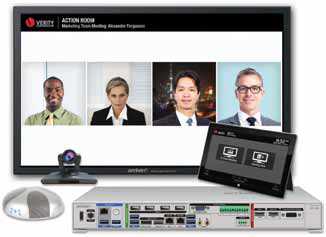The Impact of Virtualization Comes Into Sharp Focus
Pexip Infinity software enables high definition video conferencing on mobile devices, and works seamlessly with Microsoft Lync to provide an immersive conferencing experience on a corporate level. Lync users can seamlessly connect any videoconference meeting on any room or corporate infrastructure.The cloud, in combination with the proliferation of mobile computational devices, has been transformational, especially in the business community. Where once a presenter would have had to fumble for a cable in order to get his or her laptop connected to the conference room display, there is now a growing expectation that any device should be able to connect easily and seamlessly—and there are companies meeting, and even exceeding, those expectations using cloud technology.
“I used to be so cynical about the word ‘the cloud.’ To me it was just another word for the internet. But it’s actually more nuanced than that, because the internet is a technology and an infrastructure, but the cloud is more of a social and use statement,” said Christopher Jaynes, founder and CTO of Mersive. The computer-science-based company, initially funded by the National Science Foundation and other governmental entities, is leveraging the cloud to move visual collaboration from hardware to software solutions, such as its Solstice and Sol display technologies.
“It has to do with the pervasive belief that I have access to any data or application that is on the internet. It’s a social convention, almost, that we’ve adopted,” added Jaynes.
“Google is already completely in the cloud and always has been. But now Microsoft is there and Office is all cloud-based, and there are all these neat file transfer things we use every day, like Dropbox, Google Drive, and iCloud,” commented Lee Dodson, president and COO for the Americas at Arrive Systems. The company offers hardware and software platforms enabling unified communications and collaboration as well as networked media solutions.
Of course, moving to the cloud will impact the AV industry. But, said Dodson, “You’ve got to stop thinking in terms of number of wires that you’ve got connected, because in the future, media needs to be usable from a wide variety of sources, whether connected or wireless.”

“All this cabling and video switching gear is legacy, and has a particular shelf life,” agreed Jaynes. “If you compute the amount of available bandwidth via wireless technologies over time, and the commercial technologies, what’s required to move an HD signal, pretty soon you don’t have to have that video cable anymore.
“If you don’t have content delivered over a cable any longer, it changes the world for displays, because you now can view displays as shared infrastructure. I can walk into a room and have an expectation that the thing hanging on my wall is available in some way. I’ve got a smart phone in my pocket with access to great data. Why can I not now put that data on that screen?”
Pexip, a company founded by Tandberg and Cisco veterans, has identified what Simen Teigre, co-founder and CEO, refers to as the “five universal pillars” on which this transition from a hardware-based to a virtualized software-based conferencing and collaborative environment will be based. The company, which started in summer 2012, just announced the general availability of Pexip Infinity, a scalable software platform that provides personal meeting rooms for any number of users on video, voice, and mobile.
First, the platform has to be fully interoperable. “A lot of customers are deploying Microsoft Lync,” said Teigre. But there are challenges, “because every system is different, every endpoint or client is slightly different, so it’s really hard to make it work well and simply for the user.”
Second, “All of the conference platforms out there have typically been hardware-based, custom developed DSP and FPGA-based hardware platforms, and there’s no reason for that anymore. Actually, it’s holding us back, both from a cost and complexity standpoint,” he said.
Virtualization is the third key pillar: “Customers want to align what they do with IT overall. They want to simplify how they manage their IT applications, they want to standardize on data centers and private clouds, and they want to use the same tools for managing all these applications. We believe that a scalable and affordable videoconferencing platform has to be virtualized to really fit into the IT architecture.”
Pillar number four is bandwidth consumption. Currently, if an enterprise opens the tap, gives everybody a software client or an endpoint, and they start using video instead of audio, he said, “It just breaks their network, so it’s a very important problem to solve.” With Pexip’s Infinity, “You can actually deploy this application around the world in your network on your data centers as one distributed application.”
Lastly, cost: specifically, licensing. Hardware conferencing solutions require large capital investment, noted Teigre. “When you run out of capacity you need to buy more—another intensive capital investment— and if you buy too much, you’re stuck with it.” The solution is a flexible software licensing scheme, he said. “You can now deploy videoconferencing capabilities to all your employees and just pay per user, rather than having to count the number of ports on your MCU [multipoint conferencing unit] box.”

“Devices don’t exist in a vacuum anymore,
and people don’t want to use them that way anymore,” noted Lee Dodson of Arrive Systems, provider of the FacePoint collaboration media system, above.Systems designers and integrators are—hopefully, for their continued survival—already well aware of the accelerating convergence of AV and IT. Where do they fit into a landscape where conference room collaboration and videoconferencing are almost pure IT?
“AV is here to stay, no matter what,” believes Jaynes. But AV integrators must decide whether they run construction or technology companies: “They’ll meet with architects and design consultants and knock walls down to build an AV system. That’s not how technology should be.”
Integrators certainly face a challenge, agreed Dodson. “This really represents one of the biggest technology adoption opportunities that this industry has seen in a long time. It’s vital for them to become proficient in IT networking technologies. They really need to have a cloud adoption strategy. Because devices don’t exist in a vacuum anymore, and people don’t want to use them that way anymore.”
Integrators might also consider adopting lifecycles that are focused more on the IT environment, said Jaynes. “Embrace things like rapid transition, quick deployment, short lifecycles, short sales cycles. Then follow it up with managed services— because it’s not about the endpoint, it’s about how you manage that endpoint.”
For example, Mersive’s Solstice will soon feature a centralized management dashboard. “The IT manager and AV consultant can sit at that dashboard and configure hundreds of displays, check analytics, and things like that,” he said.
Happily, according to Teigre, new technologies and products such as these also “give channel partners an opportunity to go back to their customers and offer an exciting new value proposition. It helps them move to more service-based, recurring business models, moving away from the box sale and trying to create more sticky service offerings to their customers.”
The capabilities of these devices also free people from having to physically gather in one room, observed Dodson. “As soon as they get their feature rooms connected to the cloud they’re going to want all of these secondary places to be used the same way. As the technology matures, it will proliferate further out from big meeting spaces or big education venues to smaller ones, and then to endpoints, and, eventually, individual workspaces. So integrators need to be looking at how they provide a product that the customer can grow with into the future.”
Steve Harvey (sharvey.prosound@gmail.com) has been west coast editor for Pro Sound News since 2000 and also contributes to TV Technology, Pro Audio Review, and other NewBay titles.
